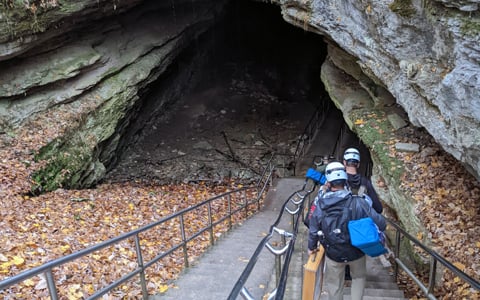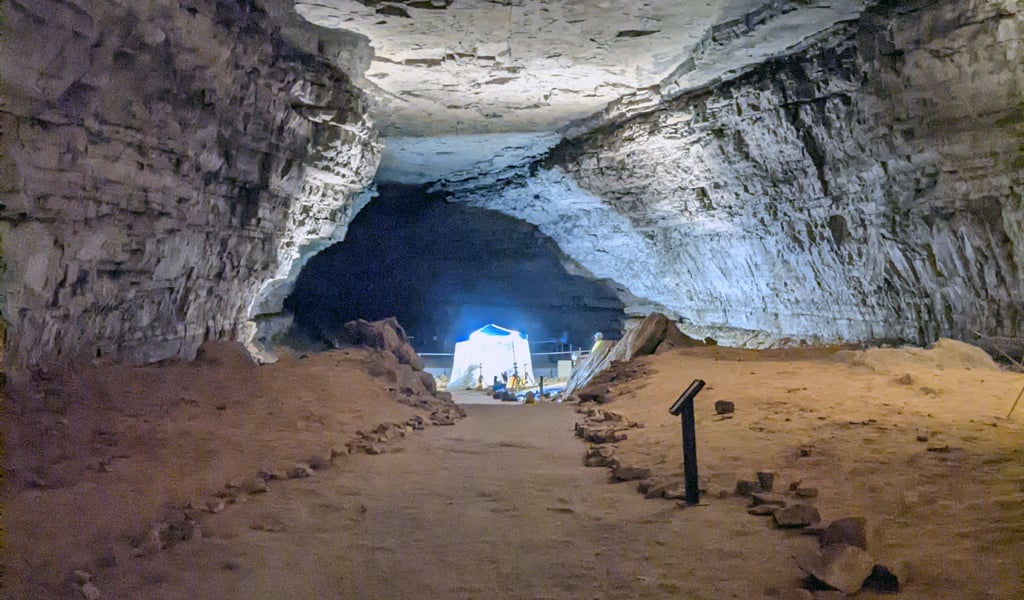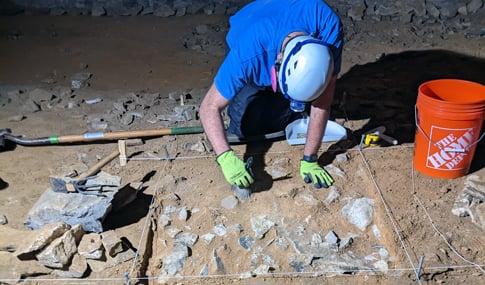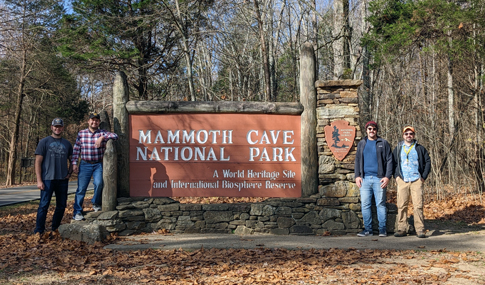
Humans have been visiting Mammoth Cave for thousands of years—gathering and mining calcite and gypsum minerals for trade and ritual during prehistoric times and mining saltpeter for gunpowder during the War of 1812. Today, more than 600,000 visitors per year walk the 85-mile surface trail system in Kentucky’s Mammoth Cave National Park, which is the world’s longest natural cave system (mapped at 426 miles long) and a UNESCO World Heritage Site.
A team of VHB archaeologists are helping the National Park Service (NPS) expand and rehabilitate trail access at the Park for a new generation of visitors. They recently conducted an archaeological survey to help evaluate the site and guide construction of the new trails with sustainable materials that lessen the impacts on the natural and cultural environment of the cave.
VHB archaeologists joined a team of VHB planners and historians already working at the Park as part of several ongoing trail improvement projects. This team, led by VHB Preservation Planner Erin Leatherbee, conducted surveys to identify historic and prehistoric resources located along the cave trails and assess, minimize, and mitigate the impacts the trail improvement projects would have on those resources.
“VHB has a longstanding relationship with the NPS at Mammoth Cave, but this is the first time we’ve provided archaeological services,” said Ben Donnan, Manager, Geophysical Archaeology. “Our particular survey showed evidence that the area has been important to people as early as 1610 BC.”
The archaeological survey took place in the Park’s historic Rafinesque Hall, along the Upper Historic Tour Route. Park visitors experience aspects of what Native American explorers encountered over the last 4,000 years via the high ceiling and broad passageway of Rafinesque Hall on the Mammoth Passage Tour.



The survey uncovered and inventoried archaeological resources located on an existing trail route where improvements are proposed. Previous archaeological surveys had identified evidence of precontact people utilizing the cave going back 4,000 years. Ultimately the new trail surface will help protect the cave’s natural and cultural resources by lessening dust accumulation and keeping visitors on paved walkways. The VHB archaeology team was led by Ben and included Charley Brummeler, Archaeology Crew Chief; and Will Heflin and Joshua Davis, Archaeology Technicians.
Anatomy of an Archaeological Survey Site
VHB archaeologists spent 10 days inside the cave. They used a total station device to lay out precise test excavation units, and slowly performed excavation. Soils within the cave were rocky and consisted of natural limestone breakdown from the roof of the cave. In the 1930s, the Civilian Conservation Corps (CCC) constructed pathways through this section, which were placed over the rocky limestone and made a smooth, compact, silty clay surface. Below and within the compacted cave trail, VHB archaeologists uncovered artifacts and material that included a deer pelvis, cane fragments, torch bundle fragments, carbonized hickory, acorn, and elm seeds.
“The deer may have come in at some point and died, or something else brought it in like a human or coyote—we are not far from an historic entrance,” Ben explained.
The Park works under the guidelines of the National Historic Preservation Act (NHPA). By identifying and investigating archaeological resources, VHB Archaeologists help federal agencies seek to understand more about the cultural past, its people, and its significance and preserve our important, shared cultural heritage.
Edward Jakaitis, Cultural Resources Program Manager at Mammoth Cave National Park, said that new data adds to our understanding of resources used in the cave.
“The National Park Service works with skilled teams like VHB to protect the unique and significant cultural resources within Mammoth Cave,” said Edward. “This research allows the Park to implement important rehabilitation of Park tour trails and public access to historically significant cave landscapes. By recovering the archaeological materials, we can better understand the early uses of the cave and refine our timeline of cave exploration.”
What’s Next For the Archaeological Study of the Cave?
The materials and data recovered during the survey are being evaluated by VHB in tandem with the NPS. This will determine how the construction may proceed while avoiding disturbance to, or adversely affecting, significant archaeological deposits. Materials are taken back to a fully functioning archaeological laboratory in Atlanta where they are examined and, in some cases, sent off for carbon dating, cataloguing, and ultimately returned to the NPS for permanent curation.
VHB has been working with the NPS at Mammoth Cave National Park since 2009 and has provided services such as topographic survey, planning and compliance under the National Environmental Policy Act, trail design and engineering, and construction administration services. Projects include an extension of the Park’s accessible Echo River Springs Trail; improvements to the Mammoth Cave Hotel and parking lots; the reconstruction of 13,120 linear feet of cave tour trail, and the proposed construction of new family cabins.
Learn more about VHB Cultural Resources services.
